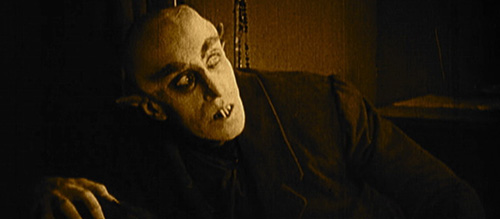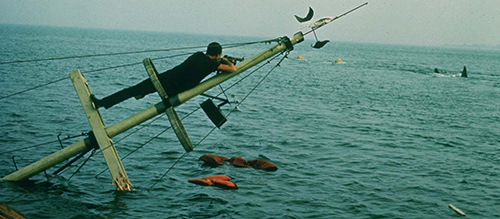Instruments of Terror: The Music In Horror Films
This article was written exclusively for The Film Magazine by Craig Sheldon.
Perhaps more so than any other genre, horror relies on a good musical score in order to fully realise its spine-chilling cinematic vision. What could be just your run of the mill horror film fare of woman getting 86ed in the shower, can instantly turn into an iconic movie moment with the slash of a violin and the saw of a cello.
A good horror soundtrack has the ability to elevate a by-the-numbers slasher flick into a truly memorable horror classic by placing a few select chords in just the right places. With the exception of a noticeable few, every great horror film in history has had a wonderfully sinful symphony heaving it over its undead shoulders and carrying it into petrifying prominence.
Our story begins on a dark and stormy night in the eastern suburbs of Paris (to be fair, it probably wasn’t stormy, but weather records for 1896 are hard to come by, so let’s just say it was), the birthplace of what is widely considered to be the first ever horror film.
Le Manoir du Diable or The Manor of the Devil is a film featuring a sword wielding hero battling the forces of evil in a creepy old manor house and, at a three plus minute runtime, was actually seen as a rather lengthy theatrical release for its time. The film isn’t exactly scary and plays more like a camp stage play then an actual horror film, but upon its completion, Le Manoir du Diable used a live orchestra to heighten the limited visuals of the time and deliver an eerie atmospheric pantomime to a paying audience.
Nosferatu (1922)
But, perhaps the first real horror film to stake its place in cinematic history (Get it? Stake.) is 1922’s Nosferatu: a silent German expressionist film famous for its pointy eared villain, inky shadow work and its shameless ripping off of Bram Stoker’s work. And while none of the original music has survived, composer Hans Erdmann’s live orchestral music has had many recreations over the years to bring a moody and dramatic weight to Count Orlok’s manicure nightmare. Unfortunately, this was the case for nearly all cinema at the time. Music was either played live during a theatrical screening or films would simply reuse already existing musical suites.
Take Bela Lugosi’s classic fanged fatale Dracula, which famously used excerpts from “Swan Lake” over the opening title sequence. It wouldn’t be until the late 1920’s that the ability to sync music with celluloid would forever change the way we experience cinema. And, just a few short years later modern film scoring as we know it roared onto screens with 1933’s King Kong (let’s face it, if a twenty-five-foot tall gorilla demands he get his own damn music, you better give it to him). What followed over the next few decades was an eruption in musical composition that encouraged a greater emotional connection to the images on screen. This technical advancement was instrumental in ushering in a new era for the horror genre. Every inch of frame could now be utilised to the fullest in an unholy union of fright and sound.
It was actually Universal’s 1935 horror entry Bride of Frankenstein that was the first mainstream horror film to feature a fully original score (I guess it takes a woman wearing the bolts in the relationship to actually get things done). Not only was Franz Waxman’s seminal score hailed upon the film’s release for injecting the franken-sequel with new life (sorry), but it would forever alter the landscape of motion pictures. Suddenly music was the hot new thing in town and no other genre would benefit more than Hollywood’s angsty teenage brother, the horror film.
So, why do horror films rely so heavily on music?
Well, take Jaws (1975) for instance…
Jaws (1975)
Well, actually, before any of you start taking umbrage with whether or not Jaws is actually a horror or not, remember that this film single dorsal finned an entire generation from wanting to go into the water. And how did it do that? Was it the constantly malfunctioning mechanical shark Bruce? Hardly. Was it the thought of finding a headless fisherman whilst snorkelling around a sunken shipwreck? Doubtful. No, the real answer is John Williams’ Oscar winning score; a score that would permeate pop culture and become synonymous with creeping inescapable doom, without which Jaws would have been a lot less memorable. Director Steven Spielberg himself stated “I think the score was clearly responsible for half the success of that movie.” And he was right. Yes, all it took were two simple notes to terrify the bejesus out of an entire movie-going audience. Well, that and Richard Dreyfus going full on double Demin with matching Denim hat. The horror.
John Williams said of his theme, it was “so simple, insistent and driving, that it seems unstoppable, like the attack of the shark.”
The theme imbues the audience with fear. It conveys a sense of approaching dread without having to show anything at all. The moment we hear those two notes we’re instantly thrown into a state of suspense. We know something bad is lurking nearby, but we can’t see it. We’re just left to let our imaginations create the fear for us. And that fear, that rush of endorphins we get with every jump scare and nail-biting build-up is essentially the drug that gets us to go back for more, again and again. Like an adrenaline addict who books the same surfing holiday every year to Amity Island.
Another horror classic that certainly used a simplified musical score to make even the most hardened of horror fanatics sleep with the lights on was 1978 picture Halloween. Director John Carpenter, who also pulled double duty as composer on the film, gave us the jumpsuit wearing stalker turned unkillable maniac Michael Myers in a rather unconventional fashion. This was a killer who never spoke, didn’t shy away from broad daylight and often went out of his way to be seen. But, by delivering a theme that conveyed the deranged obsessive nature of the antagonist, Carpenter was able to make us feel that nowhere was safe from the masked mute. Even before the first frame of the film we’re hit by the iconic theme, thrown off balance unable to properly settle down with our bag of popcorn and XL cola. It’s a fairly basic motif, but one that is absolutely true to the character of Myers in every way. It’s relentless, it never wavers and it has a deranged monotony to it that keeps you waiting for a big change in style that never comes. It just ploughs on and on in a way that tells you this guy isn’t going to stop, he is is going to get you. In a word, it’s terrifying. No wonder the iconic theme has remained almost unchanged throughout the series’ many sequels and reboots.
In the 1980’s film music was jam-packed with sounds of the synthesiser. The electronic instrument had more dials and switches than a 1940’s switchboard and used every one of them to manipulate different sounds in order to create unique and cutting-edge music. And it was everywhere. Blade Runner, The Terminator, Beverly hills cop, you name it. And horror was no exception. In 1984 a certain razor-gloved burn victim by the name of Freddy Krueger invaded our dreams with a soundtrack akin to that of a demented lullaby in Wes Cravens Nightmare on Elm Street. By using the otherworldly sounds of the synth, composer Charles Bernstein was able to transport us into the twisted mind of the stripy sweater wearing sicko with an unforgettable score. It was atmospheric, sinister and played with your sense of reality. As the theme taunted you from the background, you were never really sure if what you were seeing was real or if you were inside a character’s nightmare, and it helped to cement the film as an instant classic. Not even the “Fresh Prince” himself Will Smith was safe from Freddy’s influence, as the track “Nightmare On My Street” from 1988 payed homage to the scarred scare master, incorporating a remix of the classic main theme. More recently the influence of Bernstein’s score can also be heard in 2007’s Trick ‘R Treat, which incorporates similar musical ques.
As horror films have evolved over the years, so has the music that accompanies them. In 2002’s The Ring, a more traditional orchestral score brought a haunting urgency to the film’s washed out aesthetic, highlighting the characters race against time to solve the mystery of the deadly tape.
The 2004 hit Saw combined classical and modern musical techniques that cleverly mirrored the cultural shift toward a newer kind of horror. Suddenly torture was the name of the game and, a year later, with the release of Hostel, the term “torture porn” would become a brand new sub-genre.
When used properly, the music of horror films has always played an important character in each of the films, staying with the viewer long after the credits have rolled and all the popcorn has been swept out from under the theatre’s seats. It’s an important tool in any horror film repertoire. A shortcut to tension. A way to instil a sense of unease in the audience without showing anything at all. Whether it’s the creepy “Ki-Ki-Ki, Ma-Ma-Ma” of the Friday the 13th theme or the famous Tubular bells from The Exorcist, music is the emotional connection between film and film-goer. If you’ve ever tried to watch a horror film without the sound, you’ll know exactly what I mean.
Written by Craig Sheldon




Thank you for a thouht provoking article🙂